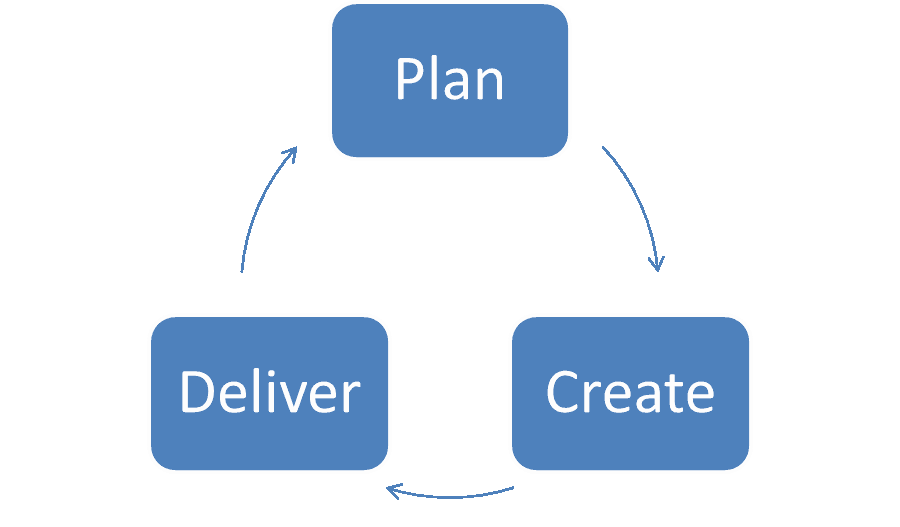Content Strategy
If you’re involved in Digital Marketing, or just digital business in general, you’ve probably heard of the term “Content Strategy”. In fact, you might already be sick of it – like all shiny new industry terms people tend to go a bit overboard, and can misappropriate it in their enthusiasm. However, done right, Content Strategy is a complex, sophisticated discipline involving many different departments, phases and tactics. In this blog post I want to explore the underlying power of Content Strategy and the benefits it can bring, so read on if you want to find out how you can get your company started on the path to content nirvana…
Why is content strategy important?
In today’s always-on and interconnected world users have increasing control over what messages they’re exposed to and how the buying process is navigated. Traditional interruptive marketing is having less and less effect as users learn to avoid the ads.
Content marketing, however, is going from strength to strength, with 99% of marketers currently using at least one content-focused tactic, although the average number employed is a staggering eight. 60% of marketers surveyed in December 2011 are planning to increase their spend in the area over the next 12 months, and industry gurus such as Seth Godin are making dramatic statements that “Content marketing is the only marketing left”. Why this continued success?
Because content marketing, when done correctly, delivers information that consumers actually want.
At its heart Content Strategy is about putting the right structures and processes in place to ensure that you can create and deliver the right content to the right users at the right time, making it a central pillar of any successful marketing plan.
A successful Content Strategy takes a content framework and incorporates brand, sales, design, user experience, development, SEO, infrastructure and more. Or, as Kristina Halvorson summarises, it’s “the practice of planning for content creation, delivery and governance”. Essentially, although the terms used differ depending on who you speak to, Content Strategy can usually be demonstrated as an ongoing management cycle:

The benefits of Content Strategy
While the benefits of content are generally understood, it can still be difficult to define the benefits of a Content Strategy and, more importantly, communicate these to your senior management to get buy-in (and budget!). It’s true that initial investment will be required, but with Content Strategy it’s all about the long term outcomes:
Improve your brand image
It’s a sad but true fact that content can often be an afterthought within an organisation; have you ever found yourself writing copy just to fill a space on your site? Now that really is wasted time, and what’s more it could actually be harming your brand if you’re putting sub-par content out regularly. Having a 6- or even 12-month strategy makes it much easier to ensure all content you release is high-quality, relevant and, above all, useful.
Get people talking about you (in the best possible way)
If you’re seen as the leader in your field people are probably going to start talking about you and, hopefully, sharing your content around. And those people are much more likely to remember you when they’re thinking about a purchase. Companies such as American Express, HubSpot and Dell have shown that committing investment to Content Strategy can produce results even when your product or service isn’t the sexiest around, and having a long-term strategic vision to convince your board with is a vital part of securing funding.
Convert leads to sales
So far you may have got people’s attention, but having a million views for your blog is useless if you’re not doing anything with those eyeballs. Although with the shifting control towards users the traditional linear idea of the purchase funnel has started to fragment, the beauty of a Content Strategy is that you can develop the building blocks of a lead nurture programme then make sure this content is available when and where prospects want to access it, reusing and adapting as required for increased efficiencies.
Make your boss love you
How amazing would it be if next time your boss asked what your quarterly content plans were you could not only tell them what you had lined up, but had the details on when and through what process each piece was going to be delivered? They’d be impressed right? Well, imagine now that along with all that you could also explain why you’re producing these specific pieces and how they’re supporting wider business goals – they might just give you a promotion on the spot. That’s the power Content Strategy gives you.

Getting started
Hopefully I’ve convinced you that Content Strategy is something you should definitely care about, but where do you go from here? There’s no denying that time and effort is required to get to grips with all the intricacies of the subject, but the following tips should help you get your strategic juices flowing:
- Firstly, define exactly what you want your strategy to deliver. Start with the big headlines (increased revenue per user (RPU), for example) then drill down into the details (increased sales of aftercare products to users) and the metrics of what success will look like (x% increase in RPU).
- Once you’ve got the outcome, work backwards to identify the steps that will take you towards that goal. Who do you need to target, and what sort of content do they need? Note that this is not necessarily what you want them to know about – to get people interested in your brand you have to provide content that’s of value to them.
- Start building the foundation for long-term plans – audit the content you already have (both quantitative and qualitative), map it to your target audiences and the buying cycle and set up an editorial calendar (free online tools such as Contently can be very useful here). Don’t forget tone of voice and brand guidelines so you can get people across the organisation contributing. Oh, and make sure you have a process in place to react to current events and news! This is often where marketers come unstuck – making the big plans is fine but finding time among day-to-day demands to execute them can be challenging (and yes, there’s a touch of personal experience here!). Calling in an agency for this phase can save a lot of time – and a fresh pair of eyes is always useful for identifying hidden opportunities!
- Stick to your processes to ensure that each piece of content you produce is of the highest quality – again, when you’re pushed for deadlines taking the time to clarify your audience, search terms, calls to action and more may seem to slow you down, but the time you’ll save by avoiding unnecessary revisions will far outweigh this (and you can also more easily explain your decisions to senior stakeholders).
- Finally, keep it up! Take the lead from Agile development principles and continually review and assess your progress. Don’t be afraid to drop things that aren’t working, or trial new ideas – just make sure you have the tools and metrics in place to test individual tactics so you have objective data to support and justify this approach.

